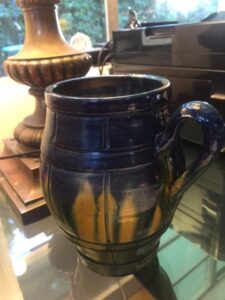 PT sent me a VERY old cider or ale mug, which dates from (I believe) before 1820. In those days, what happened all around this large vessel? What did it see if it had had eyes? Picture the late 18th century British alehouses or taverns, dark, dingy, with creaking settles, sagging cricket tables, crusty men with beards smoking pipes. If this mug had ears, it might’ve heard talk of politics, complaints about women, and curses around a card game. A fire would rage as a serving wench handed drink to the gents.
PT sent me a VERY old cider or ale mug, which dates from (I believe) before 1820. In those days, what happened all around this large vessel? What did it see if it had had eyes? Picture the late 18th century British alehouses or taverns, dark, dingy, with creaking settles, sagging cricket tables, crusty men with beards smoking pipes. If this mug had ears, it might’ve heard talk of politics, complaints about women, and curses around a card game. A fire would rage as a serving wench handed drink to the gents.
Traditionally the manufacture of these ceramic pieces centered in Stoke-on-Trent. When the late 18th, early 19th century became an era of heavy drinking, mugs manufacturing began in Staffordshire in England. Also in Pennsylvania, for the American East Coast taverns.
Mochaware or Redware
In England you find these called Mochaware, in the US called Redware. Each piece appears handmade, hand glazed, and designed to knock about. Mochaware received its name from the Moss Agate, imported in the late 18th century from Mocha, Yemen. You might think Mochaware designed for coffee because because Yemen exported a lot of coffee in those days. The name caught on because British craftsmen used the stones exported from Yemen to make jewelry. We see cravat pins from those days fashioned with cabochons of moss agate, and ladies’ brooches as well.
PT’s mug sports a drip glaze, and I suspect PT’s piece is Pennsylvanian Redware. Mochaware (UK) comes with a distinctive look, in patterns called looping earthworm, cat’s eyes, or “tree.” I think tree the most unique where the potter creates each mug’s design by dripping a preparatory wash over slip (clay). They call this mixture a “tea”, but you don’t want to drink it because it contains tobacco juice, stale urine, and turpentine or vinegar. This acidic wash created a reaction with the alkaline slip, and that reaction causes a dendric-like tree pattern. Other interesting designs in early ceramics included dipping a sponge in color, and daubing. I’ve also seen stripes, usually found on creamware, created from an 18th century pale slip.
For the Love of Ale Mugs
They didn’t only use this material to make drinking mugs, but we find them as shaving mugs, pitchers, and tableware in general. The market loves the ale mugs because we don’t find many of those due to what people used them for. Great tales of American and British tavern life at the time included pounding these mugs if someone made a bawdy joke or ripped into a politician. They slammed ale mugs on the deal tables used for boozing, called ‘firing the mug.” So, you see rarity plays a factor in the valuation of ale mugs.
A drinker usually owned their own mug they brought to the tavern. If they frequented the SAME tavern for months, the barkeep stored the mug on a hook on the back bar. Those distinctive glazes came in handy; you pointed to your mug and drank away.
Value Determinant
Older pieces come with more value. I think PT’s mug dates from 1810 or so, but twice in the 19th and 20th century this form and glazing saw reproduction. In the 1950s all things Colonial became popular in the US. During my childhood a reproduction “antique” American spinning wheel sat in our main room and George Washington crossing the Delaware hung over the faux mantelpiece. In the 1970s and 80s in England “country life” became popular which meant simple earthy pine furniture and primitive looking ceramics.
The late 19th century, an era of reviving anything from history, also saw reproductions of these ale mugs. Britain became the center of industrialization at that time, so the fashion turned back to the past for fear of the future.
If PT’s ale mug came with an imprint with a SIZE (pint for example) or a Monarch’s initials, that might confirm dating to after 1830s. The value of PT’s mug if OLD is $800. Now, I ask, would you think it worth that much? PT found it for $2 in a thrift store in Lompoc.